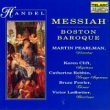Hearing the Christmas portion of MessiahJennens and Handel organized Messiah in three parts analogous to acts in an opera. The first concerns prophecies about the Anointed One, his birth, and his life and ministry on earth.The second deals with his suffering, death and resurrection, the promulgation of his message, the opposition to it, and the final triumph of God. The third tells of the life to come, victory over death, and God’s eternal glory. Within each part Jennens gathered his texts into smaller groups, analogous to scenes, of two, three or four movements which work out the progress of an idea or theme. The topics of these sets, which he identified in his workbook,3 will be included in the relevant sections in the following discussion. Handel must have recognized these groupings, for he set individual numbers (in the version of the Gesellschaft score) in related keys within sets that parallel Jennens’ arrangement. I see the Overture as connected to the opening tenor recitative and place it within Jennens’ first grouping. Also, Jennens had not accounted for Handel’s inclusion of the Pifa, or pastoral interlude, prior to the angel’s announcement to the shepherds; I include that within the fourth set or scene. PART I[Set 1: Overture (E minor), tenor accompanied recitative and air (E major), OVERTUREAs he would with any opera, Handel created a Sinfonia--an overture--for this oratorio. It is in the French style, a tradition for works of a serious nature. Its orchestration is quite simple: two oboes, violins I and II, violas and continuo consisting of keyboard, cello, violone, and bassoon.4 In Handel’s E-minor music a near-tragic picture emerges. The opening part, marked Grave, is homophonic (chordal) in a rhythm of severely differentiated note values (long and very short). It contains many surprising accented dissonances. [Excerpt 1] The great tension presented here is not resolved in the ensuing faster polyphonic section, where Handel gives us a long, energized fugue subject, still in minor. This theme technically spans an octave, but works primarily in only a sixth, and concentrates in an even smaller part of that range. One might imagine a struggle in an enclosed space. Farther along in this section, rising sequences try in another way to break loose from narrow confines, only to fall downward again. [Excerpt 2] Rather than longed-for release from frantic struggle, the conclusion of the Sinfonia is a rather abrupt cadence confirming E minor.
PAGE 1 2 3 4 5 6 7 8 9 10 11 12 13 3 From http://gfhandel.org/messiah.htm 4The keyboard instrument is unspecified; harpsichord would have been the theater instrument, but organ would have been available in a church as well as harpsichord. The violone is the largest instrument in the viol family, the equivalent of today’s string bass. The bassoon is often not present in the continuo. |

